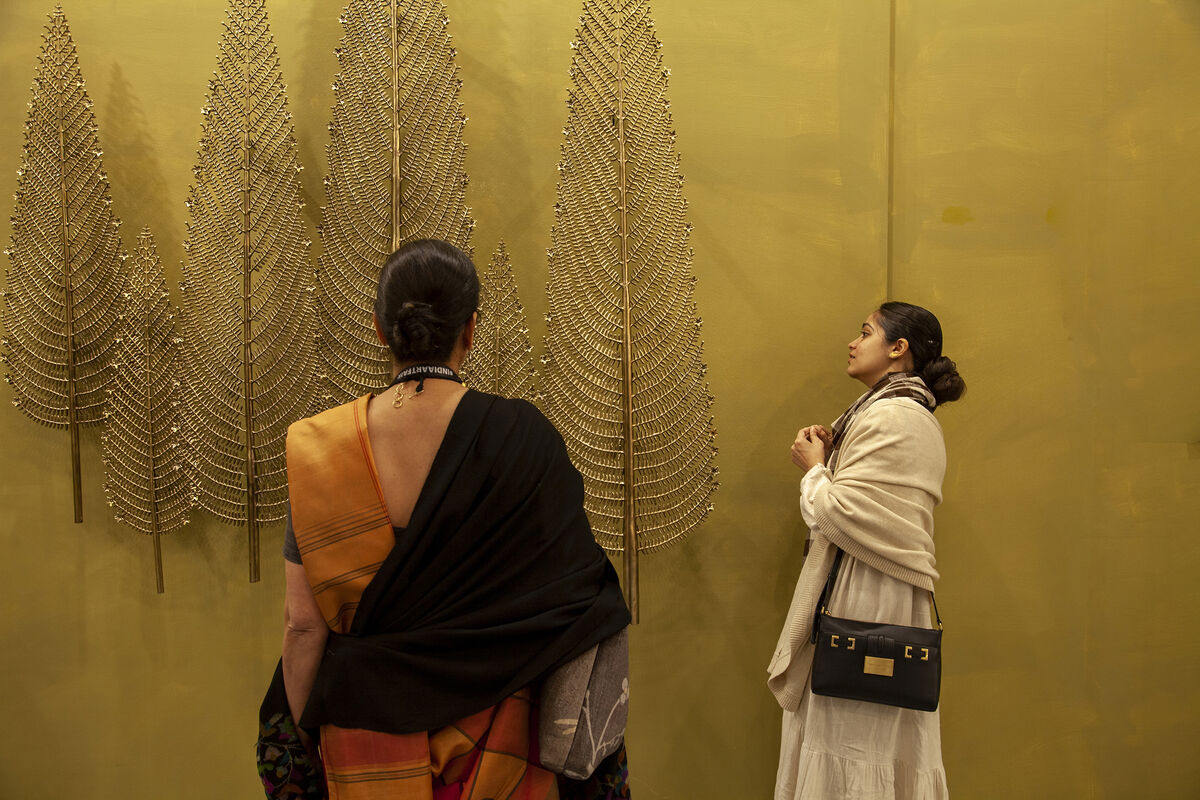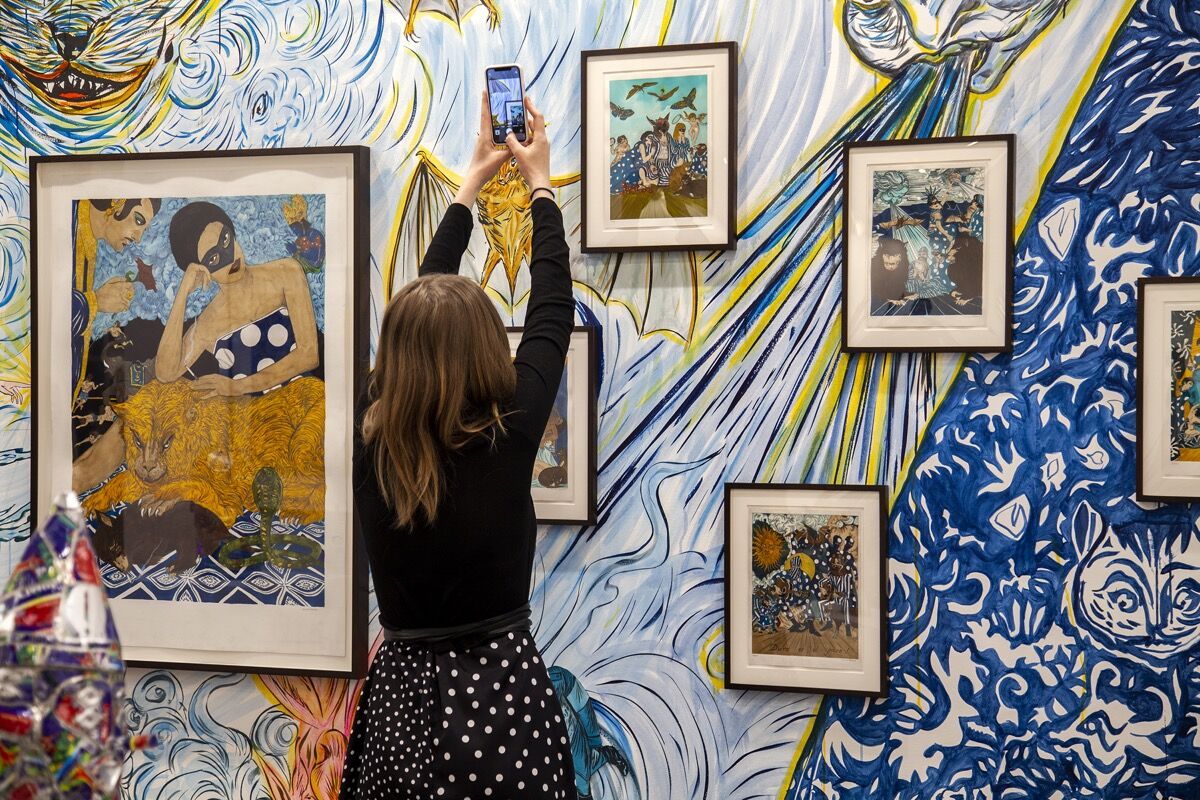
The coronavirus outbreak may be keeping art collectors away from cities such as Hong Kong and Singapore, but it didn’t affect footfall at the India Art Fair (IAF) in New Delhi earlier this month.“I’m sure if people came here they would be very surprised,” said Indonesian collector Tom Tandio while standing in a bustling fair aisle. “A lot of international collectors have the wrong perception about contemporary South Asian art. They think it’s very traditional, but it’s not.”Once a regional fair that attracted little attention overseas, the 12th edition of IAF drew a large contingent of collectors, curators, and museum groups from across the world. As the biggest fair in South Asia, it devotes 70 percent of its floor space to galleries from the subcontinent so artwork from India, Pakistan, Bangladesh, and Sri Lanka can take center stage. Of the 81 exhibitors at this year’s edition, there were only a handful of international galleries, but they were major players—such as New York–based gallery David Zwirner and Berlin’s neugerriemschneider.

IAF was briefly owned by MCH—the parent company of the Art Basel fairs—as part of its attempt to build a portfolio of regional fairs. However, due to a change in strategy, MCH sold its majority stake in IAF to Hong Kong–based events company Angus Montgomery Arts in 2019.“There has been a big change this year,” said Jagdip Jagpal, the director of IAF, stressing growing international interest in the region. “People come across works by South Asian artists in Europe and the United States, which has piqued their curiosity, so they came to Delhi. There’s really been an impact.”

Indeed, an increasing number of contemporary artists from South Asia have been appearing in prominent international museum exhibitions. In 2018, British Bangladeshi artist Naeem Mohaiemen won the Turner Prize. Last year, the Museum of Modern Art’s major rehang turned the spotlight onto several artists from the subcontinent, and Indian sculptor Mrinalini Mukherjee, who is known for her fabric works, had a long-overdue retrospective at the Metropolitan Museum of Art. India also made its return to the Venice Biennale in 2019, after an eight-year hiatus.“Before, there was a sense in which museums felt that you could bundle South Asian artists together,” said Mortimer Chatterjee, co-founder of Mumbai-based gallery Chatterjee & Lal. “But we are seeing less survey shows than 10 years ago. Now, you are seeing Indian artists in solo or group presentations [with other international artists]. Buyer confidence is much more pinpointed to specific artists rather than the region in totality. In the past, all Indian artists rose at the same time, but then when the market crashed, everyone crashed together. Now each artist has their own independent trajectory, which is much more sustainable.”
When the boom went bust
several leading artists at auction, flipping them for record prices. “I remember going to an art fair where we were selling an artist at a certain price, and the same week, he was selling at auction at five times that. It was just nuts,” Chatterjee recalled.After the onset of the global financial crisis in 2008, the art market bubble burst and prices plummeted. Since then, the South Asian art market has made a slow recovery. While collectors were quick to return to more established modernists—such as Francis Newton Souza, M.F. Husain, andS. H. Raza—who continue to fare well at auction, contemporary art took a bigger hit.M. F. HusainIndian Households, 2008-2011Victoria and Albert Museum (V&A)The recovery has also been impacted by new governmental policies in India, such as the introduction of the 12 percent Goods and Service Tax (GST) in 2017 and banknote demonetization in 2016. But the market is finally stabilizing. Last year, ArtTactic moved South Asia up from ninth to sixth place in its global outlook rankings, and dealers are seeing increased buyer confidence in contemporary art from the region.While the total sales from South Asia account for less than six percent of the global art market share, according to last year’s edition of economist Clare McAndrew’s Art Market Report, the region is becoming increasingly important. As global sales in the online art market continue to grow, the report indicates that India will become one of the fastest-growing e-commerce markets outside China in the next five years.
Stability and a new stable of supporters
The South Asian art market has undergone a massive transformation since the downturn. “Today, contemporary art has got more depth to it as opposed to just being a business proposition,” explained Jagpal.Despite the absence of government support, the regional art ecosystem has evolved. The IAF has improved in quality, there is a stronger gallery system, and non-commercial endeavors such as the Kochi-Muziris Biennale, the Lahore Biennale, the Dhaka Art Summit, and Goa’s Serendipity Arts Festival are raising the profile of contemporary art across the subcontinent. Nonprofits such as Saat Saath Arts are spearheading major initiatives such as India’s first contemporary sculpture park, in Jaipur. Private collectors and patrons are also playing key roles, such as the mother-and-son collecting duo Lekha and Anupam Poddar, who mounted an impressive group exhibition with a political bent at their Devi Art Foundation space this month. Veteran collector Kiran Nadar is also showing a quality exhibition featuring Indian sculptor and printmaker Zarina Hashmi—alongside other leading women artists from the region—at Nadar’s eponymous museum in Delhi. While the institution currently occupies a temporary space in a shopping mall, Nadar has recently commissioned British-Ghanaian architect David Adjaye to build a new art museum in the city to hold her 6,000-work collection.“This is now a time in the market where there are deeper foundations than, say, 10 years ago, when the market was quite frothy,” said Yamini Mehta, Sotheby’s deputy chairwoman for Indian and South Asian art. “Auction houses, museums, and galleries are really looking at the contemporary art scene in a more considered way…and prices will probably rise as we see perhaps even more international attention shown to this part of the world.”

For now, however—even for artists who have broken into the international market—prices are affordable. According to Jagpal, contemporary works that sold at the fair ranged from $300 to $350,000. She would not specify what the top-priced work was, but near the upper end was a triptych of vibrant paintings by Atul Dodiya that sold for $150,000 and a blue resin-and-fiberglass head of a woman by Indian artist Ravinder Reddy, which sold for about $85,000 in New Delhi–based Vadehra Art Gallery’s booth.Several international buyers took home works priced below $50,000. New York–based Aicon Gallery sold figurative painter Mequitta Ahuja’s Le Damn (2018) for $35,000 to an Italian collector. A German collector took home a piece by Ganesh Haloi from Delhi- and Kolkata-based gallery Akar Prakar’s booth for about $34,000. Silicon Valley–based collector Asha Jadeja Motwani purchased a sculpture of baby shoes made of razor blades by Bangladeshi artist Tayeba Begum Lipi for $2,000 from Bangladeshi artist-run nonprofit Britto Arts Trust. The Brazilian gallery Karla Osorio Galeria, which recently started representing Indian artist Asim Waqif, sold one of his mixed-media works for $6,000 to a collector based between India and Germany.Outside the fair, several galleries also noted an increase in foreign collectors. For instance, Aparajita Jain, director of veteran gallery Nature Morte, said there’s been a 25 percent hike year over year in the gallery’s number of international collectors.
Indian contemporary art goes global

Brasília- and São Paulo–based Karla Osorio Netto said she had been looking to represent an Indian artist for a while. She plans to hold a solo show for Waqif at her eponymous gallery and organize an artist residency for him in Brazil this year. Akar Prakar is preparing a solo show of abstract painter Ganesh Haloi—who participated in Documenta 14—for the upcoming Asia Week program in New York. And this spring, the State Tretyakov Gallery in Moscow will open an exhibition titled “Extension: India” (June 17th to September 6th), featuring the largest collection of contemporary Indian art to ever be shown overseas.While auction houses have long focused on works by South Asian modernists—which can command six-figure sums—they are now reconsidering contemporary pieces, too. Mehta from Sotheby’s has her eye on artists such as Pakistani painter Salman Toor, Pakistani-American sculptor Huma Bhabha, and Indian video artist Hetain Patel. Meanwhile, Nishad Avari, who is head of sale, associate vice president, and specialist for South Asian modern and contemporary art at Christie’s, is also looking to expand contemporary offerings. He noted that the collector base for South Asian art is broadening: While collectors in the U.S. and India still dominate sales, interest from Hong Kong, mainland China, and Taiwan is increasing. As a result, after a 10-year hiatus, Christie’s has started including South Asian art in its Hong Kong sales.Hetain PatelDon’t Look At The Finger (still), 2017
Chatterjee & LalWithin the subcontinent, there is a growing number of committed contemporary art collectors, rather than just collectors focused on modern masterpieces. “The time for speculation has gone,” said Priyanka Raja, co-founder and director of Kolkata-based Experimenter Gallery. “Private individuals are not only collecting contemporary art in a more meaningful way, but it’s also a more immersed, research driven-process.”Dealers have admitted, however, that recent months have been challenging as protests against the Bharatiya Janata Party’s controversial citizenship amendment act continue to rock the country, creating economic uncertainty. Yet many see the success of this year’s IAF as a barometer of sorts. The growing attendance numbers, quality of contemporary art on display, and increased interest from local and international buyers were all positive indicators of change.“The art fair is a huge benchmark for how the market is looking,” said Kishore Singh, who heads exhibitions and publications at Delhi Art Gallery. “Today, you can feel a new energy.”
Payal Uttam
https://www.artsy.net/article/artsy-editorial-boom-bust-south-asian-art-market-finally-maturing



